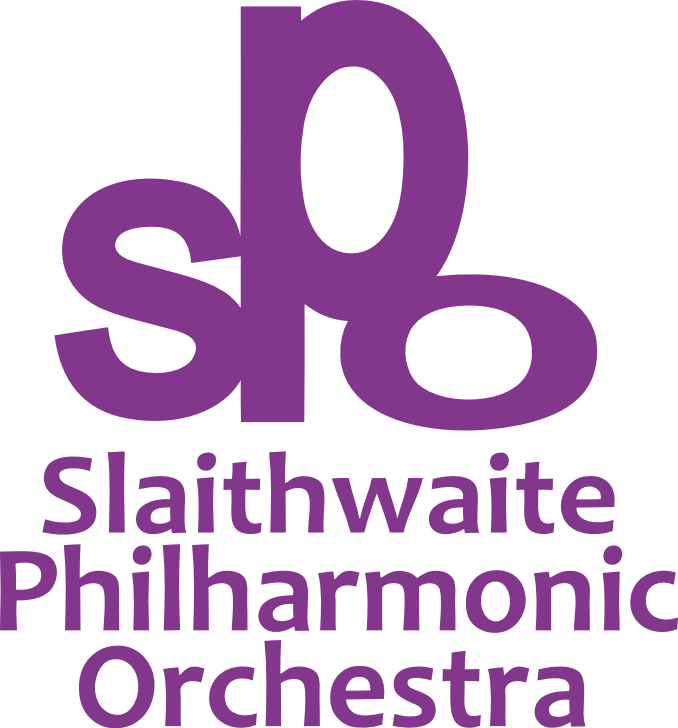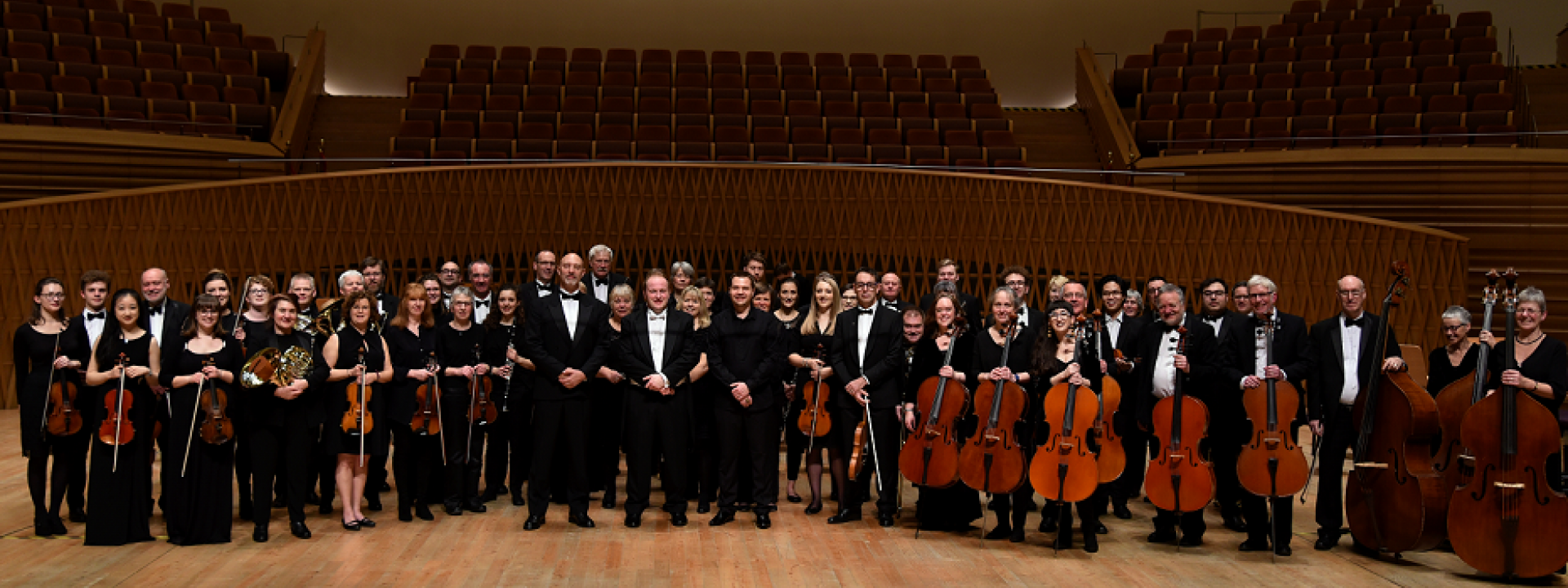Sunday 22 September 2024 - Programme Notes by Nareece Forrest
Mozart - Sinfonia Concertante for Violin, Viola and Orchestra
Wolfgang Amadeus Mozart - Sinfonia Concertante for Violin, Viola and Orchestra K364
A Sinfonia Concertante is usually described as a cross-over genre between a symphony and concerto. Involving one or more soloists with orchestra, the soloists often blend back in with the orchestral lines, giving the piece a symphonic quality. Wolfgang Amadeus Mozart wrote his for Violin, Viola and Orchestra in 1779.
Shaped in three movements, the first is marked Allegro Maestoso (fast, majestically), and opens with a succession of orchestral chords and violin arpeggios, firmly establishing the key of E Flat major. The cellos and basses start their motors with repeated quavers, above which light, interjecting sequences pass between the violins and oboes. The two horns and two oboes used throughout this piece pass little harmonious duets in thirds back and forth. Climbing trills weave through the upper strings over the continuing motor pedal in the lower strings. The violas pick up the trill call and the cellos reply, preparing us for the violin and viola soloists, who mark their first entry in octaves. This allows the deeper, richer viola to shine, whilst the violin adds brightness above. The two soloists then feature independently. First the violin professes their pretty melodic statement, then the viola responds and extends the tune, giving us a chance to hear both beautiful timbres in their own right. The rest of the movement continues in this vein, with Mozart writing sympathetically to bring out the best from both soloists. Perhaps this is clearest in the cadenza, where each player seamlessly enhances the other, creating a stunning duet. One can easily be swept away by the skillful writing and beauty here, but a duetting trill keeps our attention until the orchestra enters a final time to bring the movement to an end.
Mozart was a master of musical balance, and this is clearly on display throughout this Concertante. The violin and viola share equal parts of the limelight, whether playing exquisitely together or separately; never one overshadowing the other.
The second movement opens in C minor, and immediately establishes a wistful mood with a sombre, soulful melody in the violins. The Andante (walking) speed enhances the calm, and solo violin and viola take their turn in developing the opening theme. Mozart lightens the texture during this movement by using the horns and oboes sparingly, and creates air in the accompanying orchestral parts with rests. This provides a stunning contrast to the lyrical longer lines of the solo parts. Both players develop the melodies with either rhythmic or harmonic changes, flourishing over gentle orchestral accompaniment. Not content with one memorable cadenza, Mozart gives the soloists another glorious opportunity now - stopping the orchestra and generously furnishing each player with their own lustrous line and beautifully crafted duetting moments. Towards the end of the cadenza the viola provides extra harmonic support with double stopped notes, while the violin flutters aloft. Before the orchestra is allowed back in we hear a series of simultaneous trills, then the movement is brought to a gentle close.
It was not unheard of during the 17th and 18th Centuries for some stringed instruments to be tuned up or down to better suit the key of the music being performed. This practice is known as scordatura, and is being utilised by our solo violist. She tunes each string up a semi-tone, which enhances the brightness and volume of the open strings and allows for more natural fingerings, whilst ensuring she sounds in the correct key! Mozart wrote the solo viola part with this in mind, and it shows in the warmth of tone and better balance it creates.
As the final movement starts we're back in the home key of E flat major. The first violins immediately launch into a bright, lively dance full of trills, well-fitting the Presto (very fast) tempo. The soloists enter with a new idea – deploying a Scottish snap-like dotted rhythm. They combine this with triplet quavers scurrying up and down, keeping both players busy and the music fizzing along. Suddenly, playing in thirds, they bring back the first theme, and after a short orchestral interjection the violin and viola lead the charge back to the Scottish snap idea, which develops between the soloists. The viola quickly dips into the minor key and passes it to the violin, but both decide they prefer the sunshine and head back to the opening theme. To round off this vigorous movement both orchestra and soloists combine, giving a triumphant, symphonic ending to this masterful work.
Ludwig van Beethoven - Symphony No 1
In 1792 a 22 year old energetic Ludwig van Beethoven made Vienna his permanent home and set about developing his compositional skills. He enjoyed lessons from Joseph Haydn and studied Wolfgang Amadeus Mozart's works - two composers he greatly admired.
Initially more well known as a virtuosic pianist, Beethoven's emerging talent as a composer was cemented by his First Piano Concerto in C major (1795), various chamber works including String Trios, and his 8th Piano Sonata – the Pathetique (1799). However a symphony and string quartet were notably absent. Evidently Beethoven was reluctant to write for the genres until he felt he could sufficiently match his aforementioned esteemed forebears. Thank goodness he persevered!
His First Symphony premiered in Vienna on 2nd April 1800, and from the opening Adagio molto Beethoven's ingenuity shines. Despite following the Classical traditions of symphonic form, in a bold move Beethoven swerves establishing the home key of C major straight away by introducing harmony moving from the dominant 7th, resolving to the 'wrong' key of F major. Adding to this unsettled tonality the orchestration is also innovative. Beethoven gives the woodwinds immediate prominence with sustained chords, whilst gentle pizzicato strings support the harmony from below.
After these initial shocks we reach our C major destination, and are introduced to a light, bright theme in the 1st violins, aided by the Allegro con brio marking (fast with vigour).
Quickly the flute and oboe take over with a second idea, then the writing develops and aurally bounces us between the strings and winds. Utilising the woodwind in this way was unusual at the time, and a reviewer present at the first performance took great exception to the idea, claiming that Beethoven's writing was more appropriate for a wind-band than for a symphony orchestra. Fortunately Beethoven ignored the complaint, showing early confidence in his own ideas and forever changing the course of symphonic writing.
Towards the end of the first movement an “um-cha, um-cha” moment springs out between the whole orchestra. Half play on the beat; the other half play on the off-beat. It creates a palpable energy and is as much fun to play as it sounds! Beethoven had the same size orchestra at his disposal as Haydn and Mozart, but chooses to use the players in a very different way – creating walls of sound and mixing wind, brass and string textures together in unique ways. To end the movement he apologises for the lack of C major at the opening by giving us 22 bars of it. Arpeggios move in waves across the orchestra, spanning octaves high and low, and we finish with simple, repeated chords.
The 2nd movement is an elegant dance in 3/8, marked Andante cantabile con moto (moderately slow, with movement, in a singing style). Tonally we shift to F major, and the only instrument omitted is the 2nd flute. This gives a richness to the orchestration and shows Beethoven's instinct for originality. Inner movements in symphonies were previously lighter in sound and feel. Beethoven opened the doors for later composers to write deeper, more sumptuous slower movements.
Starting alone, the 2nd violins present the pretty melody for the first 6 bars. Violas, cellos and basses enter and repeat the theme, creating the effect of a musical round. As the other instruments take up their parts, Beethoven brings everyone together and cleverly modulates to C major. The dotted rhythm, taken from the 2nd violins' earlier melody, quietly rumbles away in the timpani, then extends across all the strings and bassoon, before dissipating as the 2nd violins bring back their opening tune. This time however they are not alone; the cellos have another idea – a light, scalic counterpoint which gently persists, complimenting the violins. The two ideas unify the rest of the orchestra and everyone builds towards a loud cadence. Immediately Beethoven uses dynamic contrast – instantly moving from loud to quiet and lightening the texture. The music softly ebbs and flows and we are gently guided to a lovely pairing - the 1st violins and flute, which blend beautifully together on moving triplets. Cushioned by the rest of the orchestra, they eventually move apart, only to bring the movement to a quiet end.
During the Baroque period (early 17th Century to 1750) composers began to request players to lean into certain notes to emphasise either the harmony or melody. This is known as sforzando. The technique continued into the Classical era, and Beethoven enjoyed using it to great effect in his many compositions. He deftly deploys it in the 3rd movement, adding an extra layer of character to the Menuetto – Allegro molto e vivace (Minuet – very fast and lively).
His choice of speed in this movement foreshadowed his following symphonies as he broke new ground. Refusing to conform to the polite rhythms of the traditional minuet, Beethoven sped it up and turned it into a wild, almost savage dance, better known as a Scherzo. This replacement for the Minuet has been adopted by many other composers since the mid 1800's, and certainly suited the exuberant symphonic writing that came so naturally to Beethoven.
The 3rd movement opens with quiet strings, however after only 5 bars there is a vast crescendo, and by bar 7 the whole orchestra comes crashing in. Coupled with the fast tempo and all notes for all players marked staccato (detached) we are whipped along with barely a breath.
To form the musical ideas here Beethoven borrows some scale-like runs and triads from the first movement, but as we are now in triple time the music feels new and dramatic.
He plays with our tonal senses by shifting up chromatically from C major to D Flat major only 32 bars in. At such a pace it takes a while for our ears to catch on! The harmonic change is only temporary however and we're back in C major well before the Trio commences.
The format of Minuet and Trio is time-honoured and offers the chance to explore new musical ideas, before recapitulating to the beginning of the movement for a final time. This Trio draws the horns, oboes, bassoons and clarinets together as they share the melodic and harmonic line and the same dotted, rhythmic pulse. The 1st and 2nd violins are the only accompaniment throughout the Trio; interjecting in octaves with doodling phrases. Quieter and a little gentler in feel, the Trio provides a marked contrast to the beginning of the movement, but the toe-tapping vivaciousness cannot be forgotten, and we finish in an arpeggiated flurry.
The finale starts with a single, paused note – G, spread throughout the players at various octaves. That doesn't explain very much, so Beethoven shows his playful side; giving the 1st violins the next 3 notes - GAB. It's still ambiguous, so he adds another note, and another... we realise the violins are climbing a scale, adding different rhythms to keep us on our toes. This scale-like idea suddenly bursts into life as the music instructs Allegro molto e vivace (very fast and lively). The violins scamper around in jolly C major as the rest of the orchestra supports them with light, animated accompaniment. The cheerful, exuberant nature of this movement is tempered with occasional glimpses into minor tonality, but the energy never leaves. Towards the end the tempo engines have two stalls – with upper strings and winds each attempting a kick-start. They fail where the 1st violins succeed, allowing the whole orchestra to reach the home stretch. Having said all it needs to say, the symphony ends in a blaze of C major chords.
It is difficult to imagine Beethoven ever felt daunted to tackle the symphonic genre. With an original voice he was a true pioneer and left an amazing legacy. His first attempt is well balanced and memorable in its own right. Perhaps Holy Roman Emperor Francis II, who attended the premiere said it best - “There is something revolutionary in that music!”




